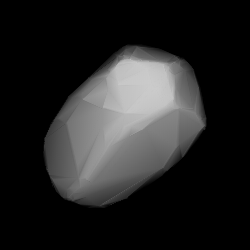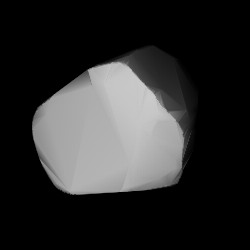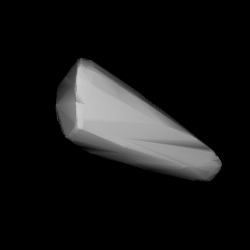Related Research Articles
2934 Aristophanes, provisional designation 4006 P-L, is a carbonaceous Veritasian asteroid from the outer regions of the asteroid belt, approximately 22 kilometers in diameter. It was discovered during the Palomar–Leiden survey in 1960, and later named after ancient Greek dramatist Aristophanes.
2436 Hatshepsut, provisional designation 6066 P-L, is a Hygiean asteroid from the outer asteroid belt, approximately 19 kilometers in diameter. It was discovered by Cornelis van Houten, Ingrid van Houten-Groeneveld and Tom Gehrels at Palomar Observatory on 24 September 1960. It was named for pharaoh Hatshepsut.
39382 Opportunity is a dark Hilidan asteroid from the outermost region of the asteroid belt, approximately 7.5 kilometers in diameter. Discovered during the Palomar–Leiden survey at Palomar Observatory in 1960, it was named for NASA's Opportunity Mars rover.

807 Ceraskia is an elongated Eos asteroid from the outer regions of the asteroid belt. It was discovered on 18 April 1915, by German astronomer Max Wolf at the Heidelberg-Königstuhl State Observatory in southwest Germany. The S-type asteroid has a rotation period of 7.4 hours and measures approximately 24 kilometers in diameter. It was named after Belarusian–Soviet astronomer Vitold Cerasky (1849–1925).

1767 Lampland, provisional designation 1962 RJ, is an Eoan asteroid from the outer regions of the asteroid belt, approximately 15 kilometers in diameter. It was discovered on 7 September 1962, by astronomers of the Indiana Asteroid Program at Goethe Link Observatory in Indiana, United States. The asteroid was named after American astronomer Carl Lampland.
4354 Euclides, provisional designation 2142 P-L, is a dark Dorian asteroid from the central regions of the asteroid belt, approximately 12 kilometers in diameter. It was discovered on 24 September 1960, by Dutch astronomer couple Ingrid and Cornelis van Houten on photographic plates taken by Dutch–American astronomer Tom Gehrels at Palomar Observatory in California. The likely C-type asteroid was named after the Greek mathematician Euclid.
10252 Heidigraf, provisional designation 4164 T-1, is a Koronian asteroid from the outer regions of the asteroid belt, approximately 6 kilometers in diameter. It was discovered during the Palomar–Leiden Trojan survey on 26 March 1971, by Ingrid and Cornelis van Houten at Leiden, and Tom Gehrels at Palomar Observatory in California, United States. The likely elongated S-type asteroid has a brightness variation of 0.56 magnitude. It was named after Heidi Graf, a former Head of the ESTEC Communications Office.

9912 Donizetti, provisional designation 2078 T-3, is a stony Rafita asteroid from the central regions of the asteroid belt, approximately 7 km in diameter. It was discovered during the third Palomar–Leiden Trojan survey in 1977, and named after Italian composer Gaetano Donizetti.
Bacon, provisional designation 3042 P-L, is a carbonaceous Dorian asteroid from the central region of the asteroid belt, approximately 9 kilometers in diameter. It was discovered on 24 September 1960, by Ingrid and Cornelis van Houten at Leiden, and Tom Gehrels at Palomar Observatory in California, United States. It was later named after English philosopher and statesman Francis Bacon.
5655 Barney, provisional designation 1159 T-2, is a Maria asteroid from the central regions of the asteroid belt, approximately 6.5 kilometers in diameter. It was discovered during the second Palomar–Leiden Trojan survey in 1973, and named for American astronomer Ida Barney in 1994. The stony S-type asteroid has a rotation period of 2.66 hours.

5196 Bustelli is a stony Eunomia asteroid from the central regions of the asteroid belt, approximately 6 kilometers kilometers in diameter. It was discovered on 30 September 1973, by Dutch astronomers Ingrid and Cornelis van Houten at Leiden, and Tom Gehrels the Palomar Observatory. The S-type asteroid was named after Italian-Swiss artist Franz Anton Bustelli.
4007 Euryalos is a larger Jupiter trojan from the Greek camp, approximately 48 kilometers in diameter. It was discovered on 19 September 1973, by Dutch astronomers Ingrid and Cornelis van Houten at Leiden, and Tom Gehrels at Palomar Observatory in California. The likely spherical Jovian asteroid is the principal body of the proposed Euryalos family and has a rotation period of 6.4 hours. It was named after the warrior Euryalus from Greek mythology.
1777 Gehrels, also designated 4007 P-L, is a stony asteroid from the middle region of the asteroid belt, approximately 13 kilometers in diameter. It was discovered during the Palomar–Leiden survey in 1960, and named for astronomer Tom Gehrels, one of the survey's principal investigators and credited discoverer.
2003 Harding, provisional designation 6559 P-L, is a carbonaceous Eoan asteroid from the outer regions of the asteroid belt, approximately 18 kilometers in diameter. It was discovered during the Palomar–Leiden survey on 24 September 1960, by astronomers Ingrid and Cornelis van Houten at Leiden, and Tom Gehrels at Palomar, California. The asteroid was later named after astronomer Karl Ludwig Harding.
10245 Inselsberg, provisional designation 6071 P-L, is a Gefion asteroid from the central regions of the asteroid belt, approximately 7 kilometers in diameter. It was discovered on 24 September 1960, by Ingrid and Cornelis van Houten at Leiden, and Tom Gehrels at Palomar Observatory in California, United States. The likely S-type asteroid was named for the German mountain Großer Inselsberg.
1247 Memoria, provisional designation 1932 QA, is a dark Themistian asteroid from the outer regions of the asteroid belt, approximately 37 kilometers in diameter. It was discovered by Marguerite Laugier at Uccle Observatory in 1932, who later named it Memoria in memory of her pleasant stay at the discovering observatory.

6257 Thorvaldsen, provisional designation 4098 T-1, is a bright Vestian asteroid from the inner regions of the asteroid belt, approximately 4.3 kilometers in diameter. It was discovered during the Palomar–Leiden Trojan survey on 26 March 1971, by Ingrid and Cornelis van Houten at Leiden, and Tom Gehrels at Palomar Observatory in California. The asteroid was named for Danish sculptor Bertel Thorvaldsen.

4230 van den Bergh (prov. designation: 1973 ST1) is a highly elongated Hildian asteroid and member of the Schubart family from the outer regions of the asteroid belt. It was discovered on 19 September 1973, by Dutch astronomer couple Ingrid and Cornelis van Houten at Leiden Observatory, on photographic plates taken by Dutch–American astronomer Tom Gehrels at the Palomar Observatory, California. The assumed carbonaceous C-type asteroid has a very long rotation period of 88 hours and measures approximately 37 kilometers (23 miles) in diameter. It was named for Dutch–Canadian astronomer Sidney Van den Bergh.
10244 Thüringer Wald, provisional designation 4668 P-L, is a Vestian asteroid from the inner regions of the asteroid belt, approximately 3.3 kilometers in diameter. It was discovered on 26 September 1960, by Ingrid and Cornelis van Houten at Leiden, and Tom Gehrels at Palomar Observatory in California, United States. The asteroid was named after the Thuringian Forest, a German mountain range.
12621 Alsufi, provisionally designated 6585 P-L, is a carbonaceous Themistian asteroid from the outer region of the asteroid belt, approximately 7 kilometers in diameter. It was discovered by astronomers during the Palomar–Leiden survey in 1960, and named for medieval Persian astronomer Abd al-Rahman al-Sufi.
References
- 1 2 3 4 "JPL Small-Body Database Browser: 1776 Kuiper (2520 P-L)" (2017-03-30 last obs.). Jet Propulsion Laboratory . Retrieved 8 June 2017.
- 1 2 3 4 Schmadel, Lutz D. (2007). "(1776) Kuiper". Dictionary of Minor Planet Names. Springer Berlin Heidelberg. p. 142. doi:10.1007/978-3-540-29925-7_1777. ISBN 978-3-540-00238-3.
- 1 2 "Asteroid 1776 Kuiper – Nesvorny HCM Asteroid Families V3.0". Small Bodies Data Ferret. Retrieved 26 October 2019.
- 1 2 3 Tedesco, E. F.; Noah, P. V.; Noah, M.; Price, S. D. (October 2004). "IRAS Minor Planet Survey V6.0". NASA Planetary Data System. 12: IRAS-A-FPA-3-RDR-IMPS-V6.0. Bibcode:2004PDSS...12.....T . Retrieved 22 October 2019.
- 1 2 3 Masiero, Joseph R.; Mainzer, A. K.; Grav, T.; Bauer, J. M.; Cutri, R. M.; Nugent, C.; et al. (November 2012). "Preliminary Analysis of WISE/NEOWISE 3-Band Cryogenic and Post-cryogenic Observations of Main Belt Asteroids". The Astrophysical Journal Letters. 759 (1): 5. arXiv: 1209.5794 . Bibcode:2012ApJ...759L...8M. doi:10.1088/2041-8205/759/1/L8 . Retrieved 8 December 2016.
- 1 2 "1776 Kuiper (2520 P-L)". Minor Planet Center. Retrieved 24 June 2016.
- ↑ Nesvorný, D.; Broz, M.; Carruba, V. (December 2014). "Identification and Dynamical Properties of Asteroid Families". Asteroids IV. pp. 297–321. arXiv: 1502.01628 . Bibcode:2015aste.book..297N. doi:10.2458/azu_uapress_9780816532131-ch016. ISBN 9780816532131.
- ↑ "Minor Planet Discoverers". Minor Planet Center. 28 December 2015. Retrieved 1 January 2016.
- ↑ "LCDB Data for (1776) Kuiper". Asteroid Lightcurve Database (LCDB). Retrieved 4 April 2017.
- ↑ Schmadel, Lutz D. (2009). "Appendix – Publication Dates of the MPCs". Dictionary of Minor Planet Names – Addendum to Fifth Edition (2006–2008). Springer Berlin Heidelberg. p. 221. doi:10.1007/978-3-642-01965-4. ISBN 978-3-642-01964-7.